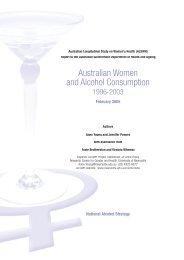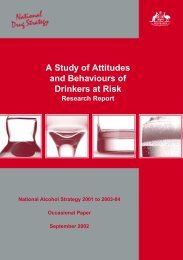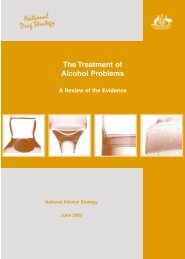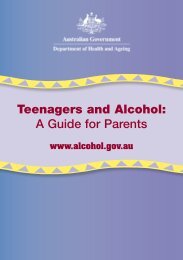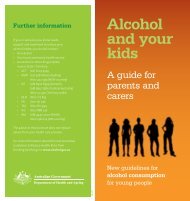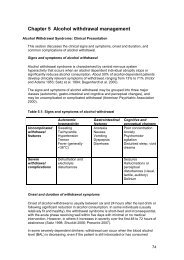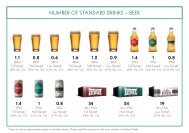Engaging the patient in <strong>treatment</strong>Patient engagement may be viewed in terms of intensity <strong>and</strong> duration of <strong>treatment</strong>participation. Higher levels of engagement are predictive of positive <strong>treatment</strong>outcomes <strong>and</strong> are, in turn, contingent upon patient, clinician <strong>and</strong> cliniccharacteristics.• Patient characteristics include pre-<strong>treatment</strong> motivation, severity of disorder<strong>and</strong> prior <strong>treatment</strong> experiences, strength of therapeutic relationship,perceived helpfulness of the <strong>treatment</strong> services.• Clinician factors include degree of empathy, therapeutic relationship <strong>and</strong>counselling skills.• Clinic factors include removal of practical access barriers such astransportation, fees, hours, physical surroundings, <strong>and</strong> perceptions aboutother patients of the service.In addition to identifying clinical disorders <strong>and</strong> effective interventions, negotiation of<strong>treatment</strong> goals requires clarification of the patient’s insight, values <strong>and</strong> expectation.There is also evidence that providing the patient with a choice of <strong>treatment</strong> optionsimproves <strong>treatment</strong> retention (Rokke et al. 1999).Treatment adherence <strong>and</strong> completion are prominent issues in alcohol <strong>and</strong> other drug<strong>treatment</strong> <strong>and</strong> the factors that improve it are not yet well understood (Mattson <strong>and</strong>Friedman 1994; Mattson et al. 1998). A focus in early interactions with patientsshould be on maximising engagement with the professional <strong>and</strong> the service <strong>and</strong>fostering a sense of collaboration (Zweben 2002; Zweben <strong>and</strong> Zuckoff 2002).Central to the provision of any intervention is a strong bond <strong>and</strong> therapeutic alliancealliance between patient <strong>and</strong> clinician (Sh<strong>and</strong> et al. 2003). Basic counselling “microskills” including warmth, empathy <strong>and</strong> optimism, <strong>and</strong> strong interpersonal skills areassociated with better retention in <strong>treatment</strong> <strong>and</strong> indirectly with better <strong>treatment</strong>outcomes (Sh<strong>and</strong> et al. 2003; Miller <strong>and</strong> Rollnick 2002).Goal setting: abstinence, moderation <strong>and</strong> reduced drinkingIdentifying <strong>and</strong> agreeing upon <strong>treatment</strong> goals regarding alcohol consumption is animportant process for many patients.For patients with no or low levels of dependence, <strong>and</strong> who are not experiencingsignificant alcohol related harms, a goal of moderation may be achievable (Sitharthanet al. 1997; Heather 1995).For patients with severe alcohol dependence, <strong>and</strong>/or those presenting withassociated problems such as organ damage, cognitive impairment <strong>and</strong> co-existingmental health problems, the most realistic drinking goal is likely to be abstinence(Edwards et al. 2003).Often patients may wish to drink at levels that can continue to cause harm, or maynot be realistically sustained. Several options can be considered when the patient’s38
expressed preference for moderation is at odds with clinician advice (Miller <strong>and</strong> Page1991; Jarvis et al. 2005). Options include• to decline assistance explaining that it would be unethical for you to support yourpatient’s goal. However, this approach is unlikely to engage <strong>and</strong> retain the patientin <strong>treatment</strong>;• to accept the patient’s goal on a provisional basis for a stipulated period of time,<strong>and</strong>:1. negotiate a period of abstinence (e.g. one to three months) with therationale that this would allow the patient to get through withdrawal (ifrelevant), provide some much needed recovery from the effects ofalcohol, <strong>and</strong> provide time to acquire new skills that can be applied tolearning moderation (controlled drinking strategies);2. agree on a gradual tapering down of drinking towards abstinence, settingrealistic, intermediate goals, <strong>and</strong> monitoring the number of drinksconsumed daily;3. negotiate a period of trial moderation, with daily drink monitoring <strong>and</strong>controlled drinking strategies (coping skills training).Central to this process is ongoing review <strong>and</strong> monitoring of drinking against identifiedgoals. If these goals are too difficult to achieve, then abstinence may seem a morereasonable goal, <strong>and</strong> this should be clearly identified <strong>and</strong> agreed upon with thepatient from the outset. Interventions with some patients require protracted butimportant negotiation for goal setting (Miller <strong>and</strong> Page 1991; Jarvis et al. 2005).Recommendation3.22 Patients should be involved in goal setting<strong>and</strong> <strong>treatment</strong> <strong>planning</strong>.Strength ofrecommendationALevel ofevidenceIDevelopment of <strong>treatment</strong> care planInformation obtained during <strong>assessment</strong> is used to develop a case formulation withpatients, that entails a shared underst<strong>and</strong>ing of alcohol <strong>and</strong> other drug problems, coexistinghealth <strong>and</strong> social problems <strong>and</strong> other concerns, <strong>and</strong> to formulate hypothesesabout their development, maintenance <strong>and</strong> inter-relationships (Baker et al. 2007).Any <strong>treatment</strong> plan must address the patient’s presenting problem. Often, thepresenting problem is alcohol-related (e.g. liver disease, depression, domesticviolence), <strong>and</strong> it will be necessary to also address the patient’s alcohol use in orderfor comprehensive <strong>and</strong> longer term changes to take effect. However, the sequence ofinterventions is often determined by immediate needs (e.g. hospitalisation for hepaticfailure or suicidal attempt, emergency shelter to avoid further violence).Treatment options should be discussed with patients (<strong>and</strong> their families or carers asrelevant), identifying• what is involved with each <strong>treatment</strong> approach,• the likely outcomes (including potential adverse outcomes), <strong>and</strong>• provide the patient the opportunity to raise questions or concerns.As in any health care intervention, informed consent is essential.A stepped care model is proposed that serves as a guide to clinical decision making<strong>and</strong> <strong>treatment</strong> <strong>planning</strong> (Sobell <strong>and</strong> Sobell 2000). Stepped care identifies that39
- Page 5 and 6: The third question of the AUDIT tak
- Page 7 and 8: Two screening instruments - TWEAK a
- Page 9 and 10: CDT and GGT are used in some clinic
- Page 11 and 12: instruments may be useful in select
- Page 13 and 14: theory has been tested widely, most
- Page 15 and 16: compulsive drinking style. The vali
- Page 17 and 18: A limited range of measures of ment
- Page 19 and 20: education, ethnic background, langu
- Page 21: Assessing riskFull risk assessment
- Page 25 and 26: ReferencesAertgeerts, B, Buntinx F,
- Page 27 and 28: Dawe, S, Loxton N, Hides L et al. 2
- Page 29 and 30: Kurlowicz, L and M Wallace 1999, Th
- Page 31 and 32: Proude, E, Britt H, Valenti L et al
- Page 33 and 34: Stockwell, T, Hodgson R, Edwards G



